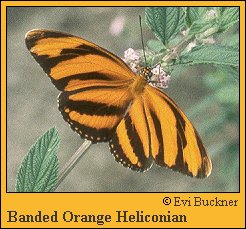 |
 

 |



Banded Orange Heliconian (Dryadula phaetusa Linnaeus)
Wing span: 3 3/8 - 3 1/2 inches (8.6 - 8.9 cm).
Identification: Male upperside bright orange with heavy black stripes; female duller with blurred black stripes.
Life history: Eggs are laid singly on stems and leaves of host plants. Caterpillars chew slots into the leaves. Adults roost in small groups on grass.
Flight: July and December in Texas, all year in the tropics.
Caterpillar hosts: Various species of passion-vine (Passiflora and Tetrastylis).
Adult food: Flower nectar and bird droppings.
Habitat: Lowland tropical fields and open areas.
Range: Brazil north through Central America to central Mexico. Rare vagrant to Kansas and Texas.
Conservation: Not necessary for rare stray.
The Nature Conservancy Global Rank: G5 - Demonstrably secure globally, though it may be quite rare in parts of its range, especially at the periphery.
Management needs: None reported.
References:
Opler, P. A. and V. Malikul. 1992. A field guide to eastern butterflies. Peterson
field guide #4. Houghton-Mifflin Co., Boston. 396 pages, 48 color plates.
Scott, J. A. 1986. The butterflies of North America. Stanford University Press,
Stanford, Calif. 583 pages, 64 color plates.
Author: Jane M. Struttmann

